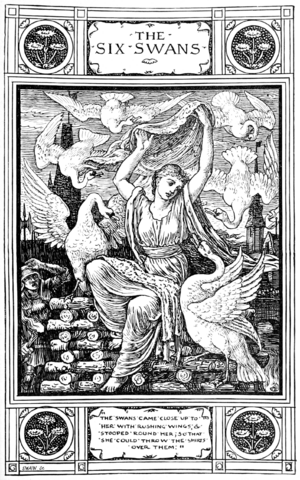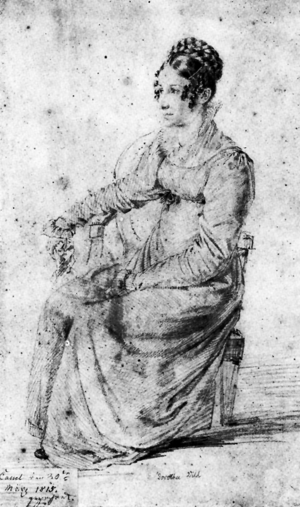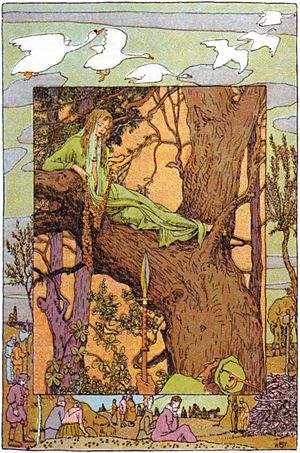The Six Swans facts for kids
Quick facts for kids The Six Swans |
|
|---|---|

Illustration by Walter Crane (1882).
|
|
| Folk tale | |
| Name | The Six Swans |
| Data | |
| Aarne–Thompson grouping | ATU 451 |
| Country | Germany |
| Published in | Grimm's Fairy Tales |
The Six Swans (in German: Die sechs Schwäne) is a famous fairy tale from Germany. The well-known Brothers Grimm collected and published it in their book Grimm's Fairy Tales in 1812.
This story is a type of folk tale called ATU 451. This type is about "The Brothers Who Were Turned into Birds." You can find similar stories all over Europe. Some other tales like this include The Seven Ravens and The Wild Swans.
Contents
How the Story Began
The Brothers Grimm first shared "The Six Swans" in 1812. They later rewrote parts of it in 1819. They heard the story from Henriette Dorothea (Dortchen) Wild, who later became Wilhelm Grimm's wife.
What Happens in the Story
A king gets lost deep in a forest. An old woman helps him find his way out. But she has one condition: the king must marry her beautiful daughter. The king feels uneasy but agrees.
The king already has six sons and one daughter from his first marriage. He worries his new wife might harm them. So, he sends his children away to a secret castle to keep them safe. He visits them there in secret.
-
-
- The Wicked Stepmother's Plan
-
The new queen, who is now the children's stepmother, learns magic from her mother. She soon finds out about the king's six sons. She decides to get rid of them. She sews six special magical shirts. Then, she goes to the hidden castle where the children are. She throws the shirts over the boys. This turns them into swans!
The swan brothers can only become human for 15 minutes each evening. They tell their younger sister, who is still human, about a way to break the curse. She must make six shirts out of nettles. The hardest part is that she cannot make a single sound for six years. If she speaks, the spell will never break. Her brothers will stay swans forever.
The brave girl agrees to this difficult task. She runs away and hides in a hunter's hut. There, she spends all her time silently gathering nettles and sewing the shirts.
-
-
- A New King and New Troubles
-
Years pass. The king of another country finds the girl. He is amazed by her beauty and takes her to his royal court. He plans to make her his queen.
However, the king's mother is very proud and snobbish. She does not think the quiet girl is good enough to be a queen. When the young queen gives birth to her first child, the wicked mother-in-law does something terrible. She takes the baby away. Then, she falsely tells the king that his queen killed and ate their child. But the king loves his queen and refuses to believe it.
The young queen gives birth to two more children. Both times, the mother-in-law hides them away. And both times, she lies and says the queen ate her babies. The king tries to protect his queen, but he cannot keep defending her forever. Since the queen cannot speak to defend herself, she is sentenced to a terrible punishment: to be punished as a witch.
All this time, she has held back her tears. She has not spoken a word. She keeps sewing the nettle shirts, no matter what.
-
-
- The Curse is Broken
-
On the day she is to face her punishment, the queen has finally finished all the shirts for her brothers. She brings the shirts with her. Just as she is about to be punished, the six years of silence end. The six swans fly through the air and arrive!
She quickly throws the shirts over her brothers. They turn back into human form! In some versions of the story, the youngest brother's left arm remains a wing. This is because the sister could not finish one sleeve of his shirt in time.
Now, the queen is free to speak. She can finally defend herself against the false accusations. Her brothers support her. In the end, the evil mother-in-law is the one who faces the terrible punishment she tried to give the queen.
Different Versions of the Story
Many versions of this tale exist across Europe. They often change small details, like the number of brothers or what kind of birds they become.
How Many Brothers?
In the Brothers Grimm's story, there are six brothers. But in other versions, the number of brothers can be different. Sometimes there are three, seven, or even twelve brothers. It is rare to find stories with two, eight, nine, ten, or eleven brothers. For example, a Danish fairy tale from 1823 is called "The Eleven Swans."
What Kind of Birds?
The kind of bird the brothers turn into also changes. In some stories, they become ducks or ravens. Other times, they are eagles, geese, peacocks, blackbirds, storks, cranes, or even jackdaws.
For example, a Polish tale tells of "The Twelve Princes who became Eagles." An Irish story features "The Twelve Wild Geese." In a Hungarian tale, the brothers turn into "Seven Cranes."
Sometimes, the brothers even turn into other animals. Folklorists have found versions where they become deer, wolves, or sheep.
The Story's Impact
"The Six Swans" has inspired many new stories and shows.
- Daughter of the Forest is a book by Juliet Marillier. It retells the story in a medieval Celtic setting. A young woman named Sorcha must sew six nettle shirts to save her brothers from a witch's spell. She must stay silent until the task is done.
- An episode of the anime series Grimm's Fairy Tale Classics features this story. The princess, named Elise, saves her brothers. In this version, the evil stepmother also acts as the wicked mother-in-law.
- "The Three Ravens" episode of Jim Henson's The Storyteller is another retelling. Here, the king's three sons turn into ravens. The princess must stay silent for a very long time to break the spell.
- The novel Birdwing by Rafe Martin follows the youngest prince. He grows up with a wing instead of one arm because his sister could not finish his shirt.
- Moonlight by Ann Hunter is a retelling set in an alternate Ireland. A princess named Aowyn must protect her family from a witch.
- The novel The King of Ireland's Son by Padraic Colum includes a similar tale. In it, a queen's wish accidentally turns her sons into wild geese.



